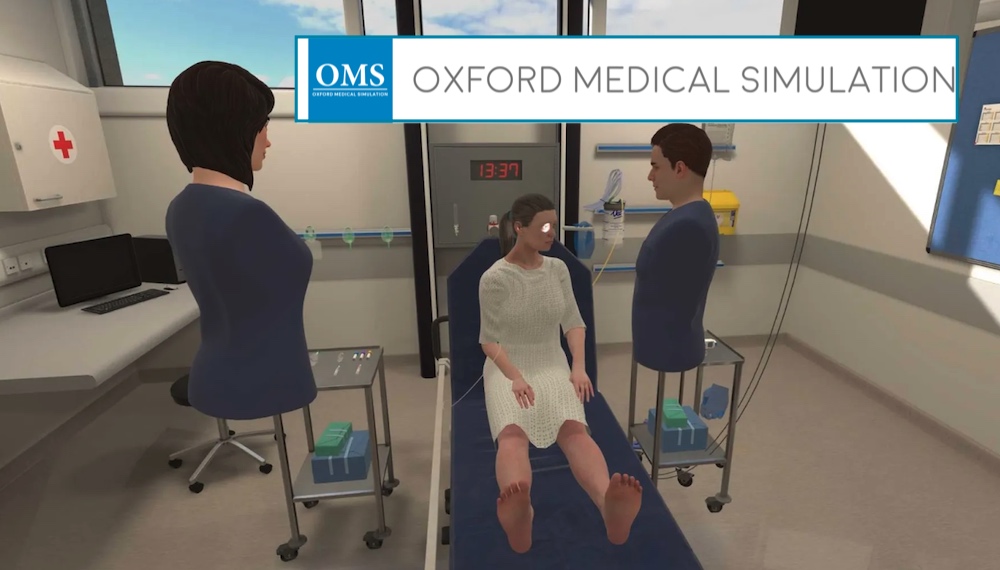Oxford Medical Simulation Announces New Multiplayer Platform for IPE
Just ahead of IMSH 2020 in San Diego, Oxford Medical Simulation (OMS) is excited to announce the launch of multiplayer virtual reality training with the launch of OMS Interprofessional, a multiplayer VR simulation platform. OMS Interprofessional allows multiple learners to be in the same virtual reality scenario at one time, whether they are in the same room or different countries. Previously we covered about OMS for VR nurse education and training, but here we take a deeper look at this new IPE functionality that will further enhance medical simulation opportunities for interprofessional training. Also, be sure to check them out at the International Meeting for Simulation in Healthcare.
What is OMS Interprofessional?
OMS Interprofessional is the multiplayer VR simulation platform from Oxford Medical Simulation (OMS). OMS Interprofessional allows multiple learners to be in the same virtual reality scenario at one time, whether they are in the same room or different countries. Learners can collaborate, discuss and make decisions as a team, just like in real life, to improve patient care.
Sponsored Content:
Driven by the OMS mission to provide healthcare professionals with quality, effective clinical training at scale, their multiplayer scenarios are fully immersive and interactive. Learners across disciplines can now practice managing patients as a team in real life clinical environments without risking patient safety. This regular, flexible training builds teamwork, confidence, competence and optimizes transfer of learning to practice.
Using VR headsets, learners are immersed in clinical environments with dynamic, engaging patients in true-to-life clinical scenarios where they can assess and treat patients in collaboration with their colleagues. Learners can see multiple patients, interviewing, examining, investigating, engaging with their interdisciplinary team to treat their patient – who responds as in real life.
The focus in OMS Interprofessional is on teamwork, communication, critical thinking and clinical reasoning – allowing clinicians to apply their knowledge and learn together. After each scenario learners enter a group debriefing environment, allowing them to analyze performance as a team, discussing the case and focusing on human factors just like in traditional simulation in healthcare.
Sponsored Content:
Team performance analytics are also available to learners and faculty to facilitate debriefing, progress tracking and needs identification. Learners can enter the multiplayer environment with faculty or as independent teams allowing for flexible and adaptive use cases.
What are the Benefits of Training IPE with OMS Virtual Reality?
There are multiple benefits to integrating OMS Interprofessional into healthcare training curricula:
- Flexible: The immersive team-based scenarios allow interdisciplinary teams to work together repeatedly at any time to refine teamwork and communication skills. This flexible system lets organizations deliver simulation efficiently and effectively to improve patient care.
- Portable: The portable, stand-alone OMS system is simple set-up, while intuitive, faculty-free use allows organizations to scale simulation delivery and integrate simulation into everyday practice.
- Remote: Moreover, multiplayer VR simulation allows learners to be trained at distance, entering scenarios from anywhere in the world regardless of their proximity to faculty and physical training locations. Faculty can be based in New York and train learners in Nairobi!
- Peer-Reviewed: Every scenario accurately mirrors real-life, with peer-reviewed presentations, adaptive conversation, pharmaceutical modeling and dynamic physiology to ensure clinical realism. This provides consistently quality, standardized simulation on demand.
- Feedback: The OMS system then provides immediate, intelligent, team-based feedback on technical and non-technical skills, consolidating knowledge and facilitating debrief.
- Analytics: Detailed metrics and analytics dashboards allow organizations to objectively measure performance and track improvements over time, whilst customizable feedback and blended learning allow seamlessly integration with curriculum requirements and protocols. A full learner management system gives educators total control of training delivery, providing clinical experiences on demand to integrate seamlessly with curriculum requirements.
About Oxford Medical Simulation
Oxford Medical Simulation uses virtual reality simulation to train healthcare professionals in world-class patient management without risking lives. Physicians and nurses used to learn through “see one, do one, teach one” – training on the job with real patients. The increasing focus on patient safety and outcomes has meant this risk is no longer acceptable. Nursing simulation – training clinicians in simulated emergencies using manikins and actors – has therefore become central to training, allowing healthcare professionals to practice in a safe environment without compromising patient safety.
Clinical Simulation is highly effective. However, it is expensive, low throughput and not widely accessible, so healthcare workers cannot receive all the training they need to deliver optimal patient care. OMS removes these barriers by offering virtual reality training scenarios. These provide a completely immersive, engaging, evidence-based learning environment for all healthcare professionals. Their fast-paced, repeatable, real-life scenarios can deliver consistently excellent, standardized clinical training to physicians, nurses and all other healthcare professionals. The focus is on clinical decision-making under pressure, crisis resource management, team interaction and patient engagement – with independent clinical trials demonstrating our impact on performance.
Learn More About IPE VR Training From Oxford Medical Simulation!
Sponsored Content:

















